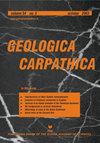上白垩纪-下古近系Jarmuta-Proč组(喀尔巴阡山脉西部Pieniny Klippen带)同造山带矿床的物源
IF 1.5
4区 地球科学
Q4 GEOSCIENCES, MULTIDISCIPLINARY
引用次数: 5
摘要
摘要Pienin-Klippen带包含向上增厚和粗化的同造山期沉积序列,见证了白垩纪晚期至古近纪早期维奇洋关闭后,奥拉维奇带状大陆与中央喀尔巴阡造山楔的碰撞。该事件的沉积记录以马斯特里赫特阶-始新世下/中期Jarmuta-Proč组的复理石/野生复理石矿床为代表。根据骨架岩石学、重矿物分析和矿物化学,我们介绍了这些矿床的物源研究结果。浊积砂岩被划分为石英质至岩屑质的砂岩。Lithic碎屑主要由碳酸盐岩和中低级别变质岩以及偶尔的镁铁质火山岩组成。重矿物组合由第一循环衍生和回收的超稳定ZTR、石榴石和铬尖晶石组成。碎屑电气石和石榴石的化学性质表明其来源于各种中低级别变质岩。在北大西洋东部观察到的高火山岩石榴石来源于高级麻粒岩和榴辉岩,可能代表了在Vahic洋裂谷作用期间挖掘出的下地壳杂岩。Cr尖晶石显示出方辉橄榄岩和二辉橄榄岩混合物源。方辉橄榄岩Cr尖晶石可能是从Klape Flysch的古老外来砾岩中回收的,因此代表了Meliata洋的蛇绿碎屑。二辉橄榄岩Cr尖晶石可能代表了从形成Vahic洋底的剥露次大陆地幔中输送的蛇绿碎屑的新贡献。本文章由计算机程序翻译,如有差异,请以英文原文为准。
Provenance of synorogenic deposits of the Upper Cretaceous–Lower Palaeogene Jarmuta–Proč Formation (Pieniny Klippen Belt, Western Carpathians)
Abstract The Pieniny Klippen Belt contains thickening and coarsening upwards synorogenic sedimentary successions witnessing the collision of the Oravic ribbon continent with the Central Carpathian orogenic wedge after the closure of the Vahic Ocean in the Late Cretaceous to Early Palaeogene. The sedimentary record of this event is represented by flysch/wildflysch deposits of the Maastrichtian–Lower/Middle Eocene Jarmuta–Proč Formation. We present results of the provenance study of these deposits, based on the framework petrography, heavy mineral analysis and mineral chemistry. Turbiditic sandstones were classified as quarzolithic to lithic arenites. Lithic fragments are predominantly composed of carbonate rocks and low- to medium-grade metamorphic and occasional mafic volcanic rocks. The heavy mineral association is composed of both first-cycle derived and recycled ultrastable ZTR, garnets and Cr-spinels. The chemistry of the detrital tourmalines and garnets suggests a derivation from various low- to medium-grade metamorphic rocks. High-pyrope garnets, observed in the eastern part of the PKB, which were derived from high-grade granulites and eclogites, represent probably lower crustal complexes exhumed during rifting of the Vahic Ocean. The Cr-spinels show a mixed harzburgitic and lherzolitic provenance. The harzburgitic Cr-spinels might have been recycled from older exotic conglomerates of the Klape Flysch, thereby representing ophiolitic detritus of the Meliata Ocean. The lherzolitic Cr-spinels might represent a new contribution of ophiolitic detritus delivered from the exhumed subcontinental mantle forming the Vahic oceanic floor.
求助全文
通过发布文献求助,成功后即可免费获取论文全文。
去求助
来源期刊

Geologica Carpathica
地学-地球科学综合
CiteScore
2.40
自引率
23.10%
发文量
26
审稿时长
>12 weeks
期刊介绍:
GEOLOGICA CARPATHICA covers a wide spectrum of geological disciplines including geodynamics, tectonics and structural geology, volcanology, stratigraphy, geochronology and isotopic geology, karstology, geochemistry, mineralogy, petrology, lithology and sedimentology, paleogeography, paleoecology, paleobiology and paleontology, paleomagnetism, magnetostratigraphy and other branches of applied geophysics, economic and environmental geology, experimental and theoretical geoscientific studies. Geologica Carpathica , with its 60 year old tradition, presents high-quality research papers devoted to all aspects not only of the Alpine-Carpathian-Balkanian geoscience but also with adjacent regions originated from the Mediterranean Tethys and its continental foreland. Geologica Carpathica is an Official Journal of the Carpathian-Balkan Geological Association.
 求助内容:
求助内容: 应助结果提醒方式:
应助结果提醒方式:


